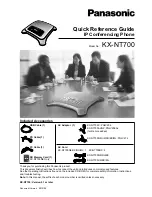
Installing Acendo Vibe
11
Acendo Vibe Conferencing Soundbars - User Guide
Connections
All connectors are located within the connector bay (rear panel).
For surface installations, place the unit face-down and open the connector bay door to manage
cables/connectors.
For wall-mounted installations, simply rotate the Acendo Vibe unit down and away from the wall to access the
connector bay.
There are two sets of connectors on the inner side panels of the connector bay. Each connector is labeled on the elastic
cable straps. Run each cable through the cable pass-thru in the bracket/door and under the cable straps.
ACV-5100 Connectors
The connectors on the ACV-5100 are shown in FIG. 11: .
Run each cable through the cable pass-thru in the bracket/door and under the cable strap
FIG. 11
ACV-5100 connector bay
ACV-5100 Connections
DC POWER
Connect the included 15V
power supply to this barrel connector. Only use the power supply included
with the ACV-5100.
OPTICAL AUDIO
Use this TOSLINK connector to receive Optical Stereo Input from an audio source device.
AUX OUT
Use this 1/8” mini-stereo connector to send analog stereo sound from the Acendo Vibe to an auxiliary
device.
AUX IN
Use this 1/8” mini-stereo connector to receive analog stereo sound from an analog audio source device.
HDMI OUT
(Type A) Connect to an HDMI input on a display device.
HDMI IN
(Type A) Connect to an HDMI output from a source device, such as a laptop or Acendo Core.
USB
Use the USB 2.0 Type-B port to connect a PC/laptop to the Acendo Vibe as a source device.
Acendo Vibe is plug-and-play with PC/laptop using standard UAC/UVC drivers.
The USB connection is also used to configure the Acendo Vibe via the Acendo Vibe Configuration Tool
for settings and firmware updates.
RS-232
3-pin captive-wire connector provides serial communication with the Acendo Vibe. Refer to the Serial
Commands section on page 31 for command definitions.
The Baud Rate for the RS-232 connector is 115200.
MOTION
(future firmware upgrade)
3-pin captive-wire connector provides connectivity for an (optional) motion sensor (reserved for future
implementation):
• PWR (+5V
0.1A)
• OCC
• Ground
The logic of OCC is "High" for occupancy detected, and "Low" for vacancy.
Analog audio input
Analog audio output
Optical audio input
DC Power input
USB (Type B)
HDMI Input (from source device)
cable strap
cable strap
RS-232 (3-pin captive wire - for Serial communication)
HDMI Output (to display)
MOTION (3-pin captive wire)
(future firmware upgrade)












































